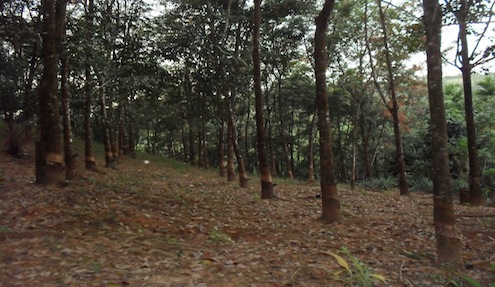IMNA – Prices for both new and existing rubber plantations in Mon State have gradually risen, while the prices of commodities are decreasing after the effects of the Burmese currency strengthening against the Thai Baht and US Dollar.

Rubber plantation prices are getting expensive after Mon migrant workers in Thailand and Malaysia have gotten involved in intensive asset purchasing in their homelands. Rubber plantation traders in Mon State buy these plantations and sell them back to the families of migrant workers with some profits.
“Plantation owners can set any price for his or her plantations. Traders are never bargaining down the prices. They just take them,” admitted a local trader.
Rubber plantations with one acre of land and 5-year-old rubber plants currently have the sales price of approximately 16 million Kyat ($21,500 US) each. Middle-aged rubber plantations, or those that have been growing rubber for around 10 years, command higher prices than newly planted plantations. But many families only want to sell their plantations if they have problems at their homes.
The price of compound rubber sheets (raw rubber material) drops down after rubber sapping stops in the rainy season. Traders are still buying compound rubber sheets from rubber growing farmers, but the farmers have almost sold the entire stock of their properties.
Nai Maung Lwin, a Mon agent for traders, said, “The price of a rubber plantation is like gold. If your plantation is near the main road and if you grow with seedling plants, the price will be higher than the natural rubber plantations. Traders come with bags of money to buy any plantations from farmers”.
The local Mon traders are also purchasing the compound rubber sheets in order to supply Chinese companies, including those who have opened offices in Moulmein, Rangoon, and Mandalay. The companies export raw rubber materials to China, which has a high demand for its industries.
During the Socialist government-era from 1962 to 1988, the State took thousands of acres of land in Mon State and implemented a big project of growing rubber for the government under Socialist marketing plans. But Mon farmers continued to grow rubber trees in small-scale farms because the land in Mon State is suitable for rubber growing.
Rubber prices grew in 2007–2008 after an increased demand from China. More Mon farmers became involved in growing rubber while the rubber prices soared, which has had a negative impact on forests and the natural environment in Mon State.
According to development workers in Mon State, deforestation in Mon State has drastically increased as trees in the mountains and hills are gradually cut down to make way for more rubber plantations.
According to government statistics, Mon State has 451, 696 acres of rubber plantations, the highest number of plantation acreage in Burma, while Tenasserim Division follows second with around 250, 000 acres. Karen State follows with 150,000 acres of rubber plantations.
In 2000–2003, when there was a military deployment in Ye Township of Mon State, thousands of acres of rubber plantation were confiscated by the new military battalions of the Burmese Army without compensation.
